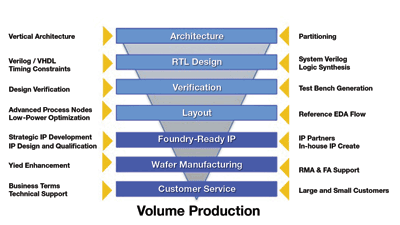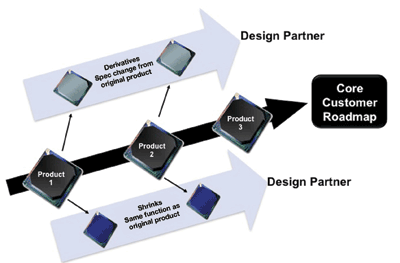A new strategy allows companies to focus their engineering teams on the places where they add the most value
BY COLIN BALDWIN
Director of Marketing
Open-Silicon, Milpitas, CA
www.open-silicon.com
The rise of the ASIC model revolutionized the way ICs were developed in the 1980s. One of the most historically interesting changes was in the separation of functional definition from physical design. The shift to an RTL/SDC-based definition for “what an IC does” also rippled through and changed the business of chip development. Many companies took advantage of the opportunity to shift their focus away from physical design and concentrate on designing product features that command value in the market.
In another part of these companies, another revolution was taking place: Silicon manufacturing was migrating from captive plants to third-party wafer foundries. As a result, the term “fab-lite” came into vogue and both fab-lite and fabless models spread through the industry. These models benefit from lowered fixed costs and effective management of the variations in demand.
Design lite
Today, the semiconductor industry is emerging from the recent global economic slowdown. Similarly to the fab-lite/fabless evolution, IC manufacturers are rethinking their strategy for IC development and are taking a closer look at how to leverage engineering partners to bring more products to market. As collaborating with a design partner allows building more products with fewer in-house staff, the term “design-lite” was coined to describe the new trend, and to draw a parallel to the fab-lite change that came before it.
One of the big advantages of design-lite is that a development company’s fixed costs become variable costs, allowing the company enhanced flexibility to adjust operating expenses in line with the current financial goals and performance. The model also allows the same fixed costs to produce expanded product lines, potentially growing both revenues and margins.
Also, innovation is enhanced as internal design teams stay focused on core product roadmap development and distractions like existing product maintenance are offloaded to the partner. Similarly, customer customization requirements can be addressed without directly impacting the core product schedules. Finally, companies can better meet time-to-market pressures with a variable-design resource team.
Collaboration
Creating a new IC requires such a significant capital investment that investors require companies to demonstrate how they can extend the return on investment through programs like derivatives that can increase profit growth. By allowing design partners such as Open-Silicon to focus on derivatives and/or shrinks (see Fig. 1 ), companies can narrow the focus of their engineering teams to the places where they add the most value those functions that are unique and command margin in the marketplace. This changing model also impacts what design-lite engineering partners need to be able to do. Figure 2 highlights the new partner engineering capabilities.

Fig. 1: A design partner enables derivatives and shrinks.
The combination of fab-lite manufacturing with a foundry partner and design-lite engineering with a design partner is paving the way for a new enablement model for derivatives. Just as successful fab-lite models are developed by fostering strategic long-term partnerships with a foundry across multiple technology generations; a successful design-lite model will depend on long-term relationships with the design partner.

Fig. 2: An enablement model for design-lite.
Flexibility
In essence, design-lite allows chipmakers to add revenue to an existing IC product line through modifications to that design without pulling the engineering team from its next generation core product roadmap focus. It also provides them the flexibility to select the right resources — from both a job role and number perspective – for the project at hand. The net result is a greater return on the overall product line investment. Just as the fab-lite and fabless models fueled the semiconductor revenue growth for last decade, derivative designs with the design-lite model can decrease the costs of new semiconductor product development and lead to industry revenue growth for this decade. ■
| Design Tasks and Teams | |
| Derivative Tasks | Team |
| Old design handoff | Internal design team |
| Updated specification and architecture | Internal design team + design partner |
| RTL design and verification | Design partner |
| Physical design | Design partner |
| Software drivers | Design partner |
| Production | Foundry partner |
Advertisement
Learn more about Open-Silicon





